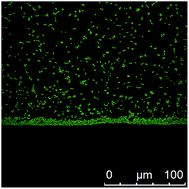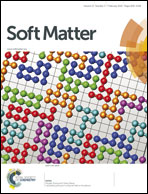In-plane particle counting at contact lines of evaporating colloidal drops: effect of the particle electric charge†
Abstract
Complete understanding of colloidal assembly is still a goal to be reached. In convective assembly deposition, the concentration gradients developed in evaporating drops or reservoirs are usually significant. However, collective diffusion of charge-stabilized particles has been barely explored. The balance between convective and diffusive flows may dictate the particle dynamics inside evaporating colloidal drops. In this work we performed in situ counting of fluorescent particles in the vicinity of the triple line of evaporating sessile drops by using confocal laser scanning microscopy. We used particles of different sizes, with different charge response over the pH scale and we focused on charged and nearly uncharged particles. Two substrates with different receding contact angles were used. Binary colloidal mixtures were used to illustrate simultaneously the accumulation of particles with two different charge states at the triple line. The deposition rate close to the triple line was different depending on the electric state of the particle, regardless of the substrate used.


 Please wait while we load your content...
Please wait while we load your content...